Bossam is a crunchy cabbage wrap filled with unctuous Korean boiled pork belly and refreshing spicy radish salad. Great as a one dish meal but also great for parties, you just can’t stop eating it, especially if you are a pork and kimchi lover.
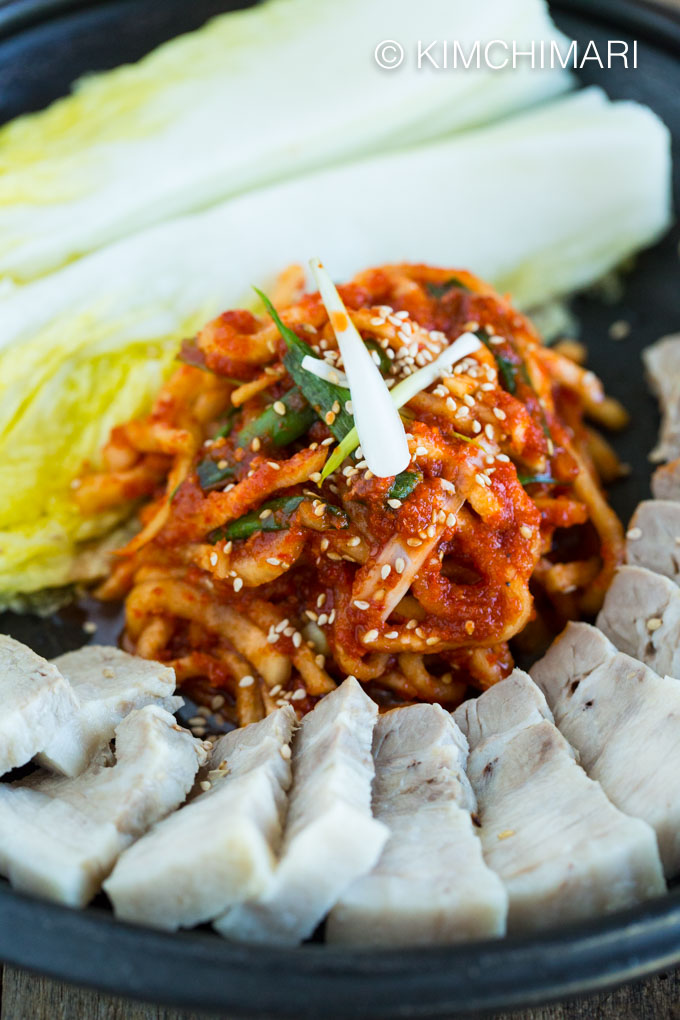
When I think of Bossam, I think of Kimjang because it was traditionally eaten around Kimjang (in the fall, Koreans make kimchi to last through winter) time when I was growing up. After a long day of pickling cabbages, chopping and making the kimchi stuffing, with your whole body smelling of Kimchi, everyone deserves a good dinner.😉
And Bossam was what moms made to feed the helpers who worked hard all day. It was such a wonderful way to end the day.
Once pork was cooked, all we needed was some leftover pickled cabbages and kimchi stuffing. OH MY.. …sooo amazing… all the different textures of crunchy and chewy, and the explosion of garlicky and spicy goodness of the kimchi stuffing in between the fatty pork..and a hint of sweetness somewhere… it was SIMPLY HEAVEN in every bite.
So next time you make Kimchi, you should make it a Bossam day!!
Meaning of Bossam – What is it?
One theory is that Bossam comes from a combination of the two letters, 복 bok and 쌈 ssam where bok means good fortune and ssam means to wrap. Koreans considered pork to bring good luck and so bok+ssam and then eventually bo+ssam meant that you were wrapping good luck in leaves.
Another theory states the name comes from the word Bossam 보쌈 itself which literally means “to wrap”. Whichever you want to go with, it’s fine as there seems to be no hard evidence to support one or the other.
How to eat Bossam
What does it consist of?
As I mentioned above, Bossam consist of the following parts:
- cooked pork belly or pork shoulder (samgyeopsal)
- spicy kimchi radish salad/stuffing (kimchi sok 김치속)
- pickled napa cabbage leaves
How to Eat – Take a piece of cabbage (rip into smaller piece if needed), put a piece of pork, then add the spicy kimchi radish salad and top it with any of the additional ingredients below such as saewoojeot and/or ssamjang to taste.
What can I serve with Bossam?
- fresh oysters (which can also be mixed into radish salad)
- saewoojeot (fermented shrimp)
- ssamjang
- other ssam greens like perilla leaves
- raw or toasted garlic slivers
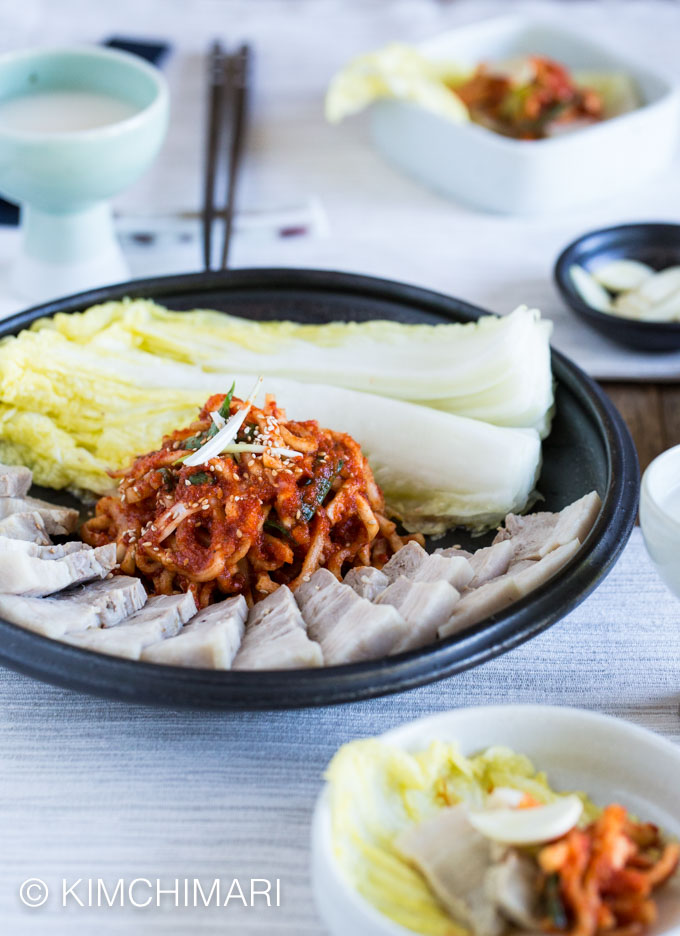
Bossam table setting with makgeolli
Different Ways to Cook Pork for Bossam
Although traditionally, pork is boiled for bossam, you can also steam it or cook it dry like my mother-in-law’s pork belly recipe here. There are also recipes for roasting the pork in the oven (much like making shredded pork) but is not traditional. Lastly, Instant Pot works perfectly for making bossam pork – which I will share soon.
Cook’s Tips for Perfect Bossam
- Best Pork Cut – Pork belly is the authentic and traditional cut to use but you can also use pork shoulder or butt. It will be less fatty which you may like better or not.
- Fresh Oysters – you can add fresh oysters to your radish salad but be sure to increase the amount of seasoning because it can become too bland after oysters are added
- Pickling Cabbages – when pickling cabbages, it’s better if you pickle it a little less than you would for Kimchi. It should be still a bit crunchy and feel that it may break when you try to bend it (as opposed to cabbage fully bending). See my Kimchi post for more info.
- Use Korean sea salt (cheonilyeom) to pickle cabbages for best result. Using just any salt will make the cabbage bitter. Cheonilyeom is Korean sea salt that has been aged for 3 years to remove the bittern. Read more about it here.
- Reserve some of the pork broth to use for drizzling the pork if the pork gets too dry before serving.
- It’s best when pork is still warm so try to time it that way.
- Storage and Reheating – pork tastes best when it’s freshly cooked but you can store in the fridge and reheat in a pan or in microwave. Personally, I prefer reheating by frying in a pan (no oil, on medium heat).
Step-by-Step Directions
For Pickling Cabbage Leaves:
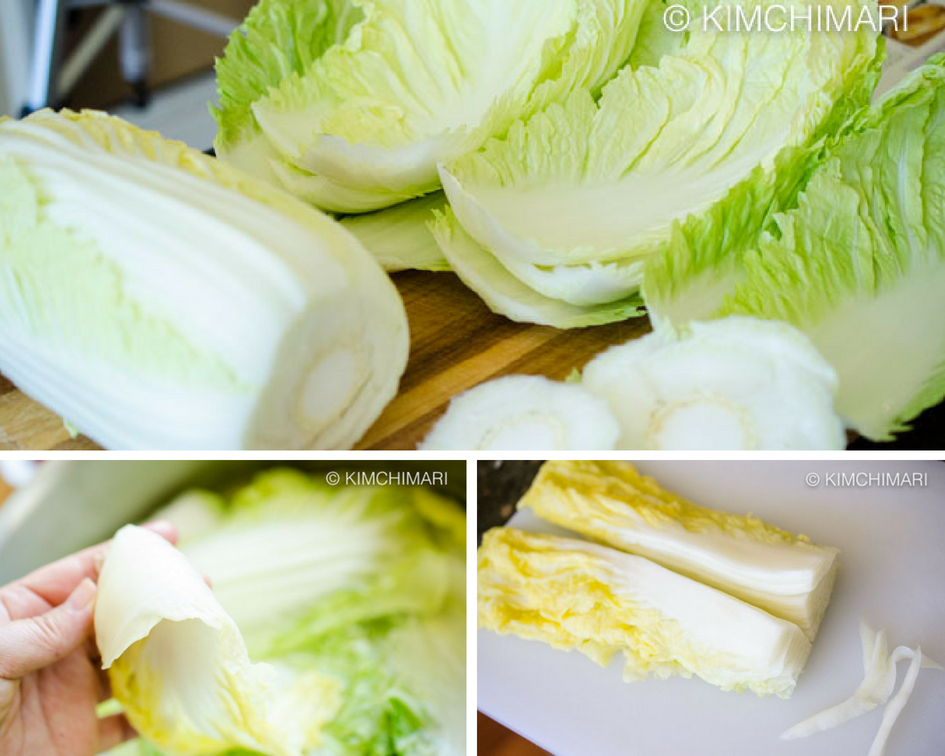
- Mix 8 1/2 cups water + 1/2 cup Korean cheonilyeom sea salt to make brine.
- Cut head of napa cabbage to loosen leaves. For this you will need about 1/2 of the cabbage.
- Immerse cabbage leaves in brine made in 1 and let it pickle for 1 1/2 hrs or until cabbage is soft and shriveled. I actually kind of like it a little less pickled with a little crunch left so probably a little less pickled than this picture. but it’s up to you.
- Drain cabbage for 10-15 minutes until fully drained. If you are not going to use right away, refrigerate up to 3 days and use later.
- When serving, cut cabbage into 1/2 lengthwise to make it easier to eat.
For Pork:
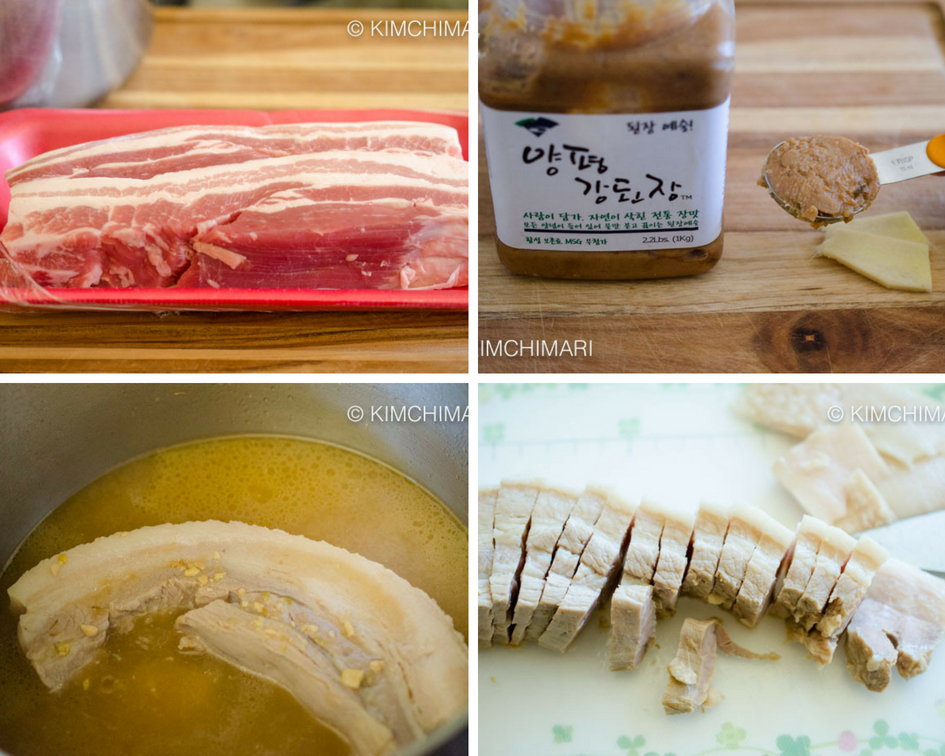
- In a pot add water, add doenjang, fresh ginger and bring to boil.
- Add pork and cook on medium heat for about 30 minutes(for 1 lb) until it becomes tender enough for a fork to go in easily. You may need to cook longer up to an hour if you are increasing the amount of pork.

Boiled Korean Pork Belly Bossam - Take pork out of the pot and let it cool for few minutes and then loosely cover with wrap or foil until it cools enough for you to slice. Reason for covering is so that it doesn’t dry out while cooling. If you can, it’s yummiest when you eat the pork while it’s warm.
For Radish Kimchi Salad/Stuffing (Kimchi sok):
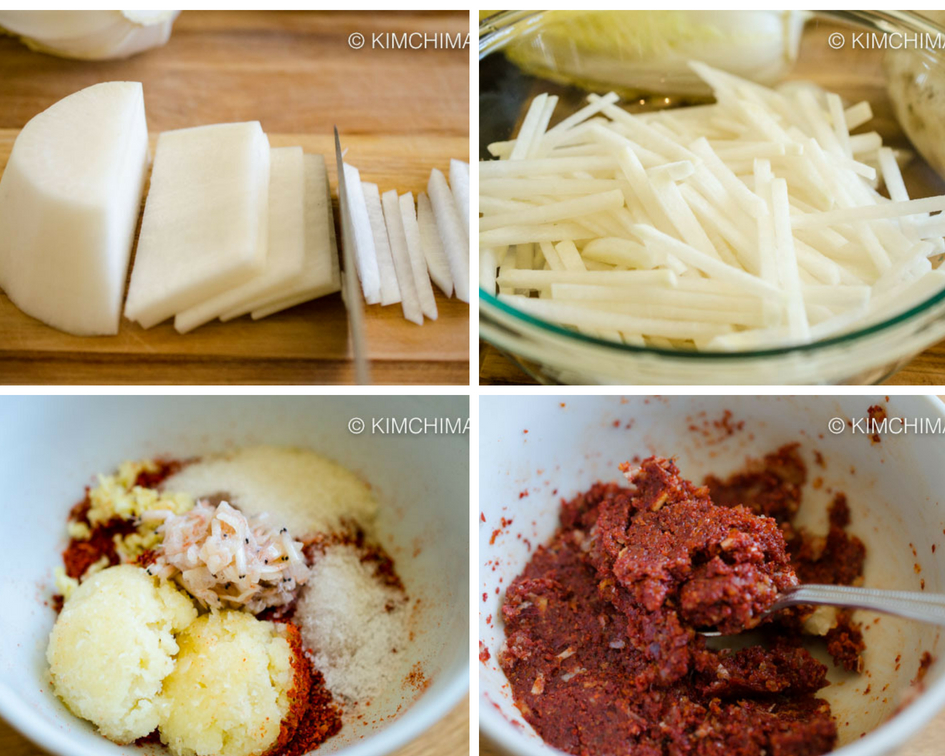
- Julienne radish – either with knife or use a mandoline.
- Cut green onions and minari (water dropwart) if you have it.
- In a small bowl, make seasoning paste by mixing Korean red chili powder, saewoojeot, anchovy sauce, chopped garlic, chopped ginger, sugar, salt except for sesame seeds.
- Add kimchi seasoning paste to bowl with radish and coat radish evenly with the paste. It may feel like it’s too dry at first but radish juice will soon make it very wet.
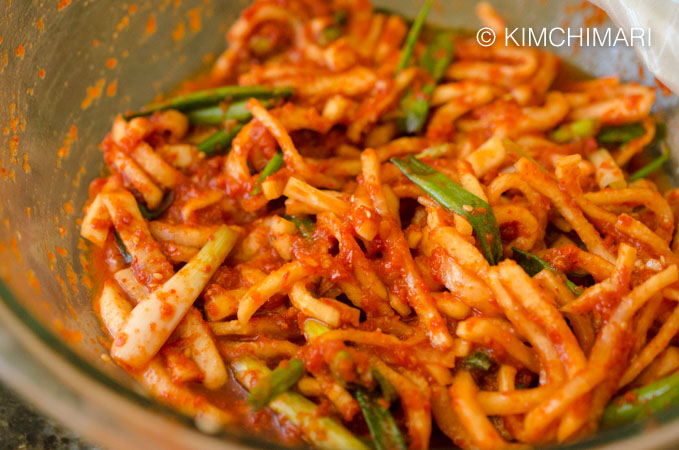
Spicy Radish Kimchi salad or stuffing all mixed and ready - Add green onions and minari and mix again. Sprinkle sesame seeds on top when serving.
*** If you want to add oysters, you need to increase the seasoning.
- Serve bossam all in one plate with pork belly slices on one side, cabbage leaves and spicy radish salad on the other side. You can of course serve all of them separately too.
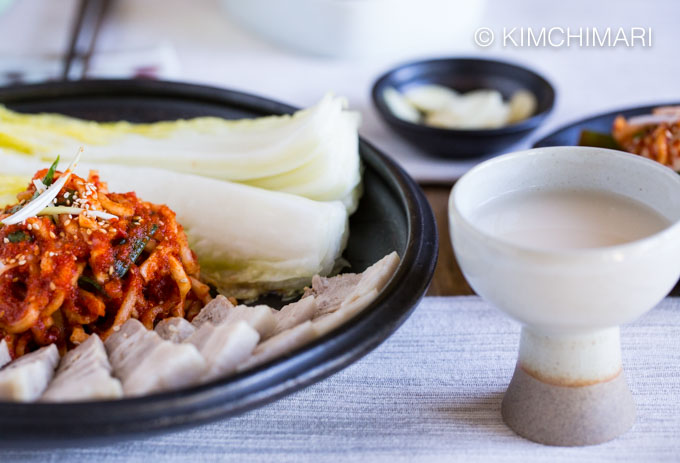
Bossam Korean Pork Belly Wrap served with Makgeolli And here’s a top view of a possible table setting for two – with an additional bowl of Spicy Kimchi Salad with oysters.

Bossam Serving Suggestion and Table Setting for two
☆ Did you make this recipe? If you liked it, please give me a 5 star rating below!
Also leave me a comment to let me know how you like it! I’d LOVE to hear from you! 😍
You can also FOLLOW ME on FACEBOOK, PINTEREST and INSTAGRAM or join my FACEBOOK GROUP to see other Korean recipes and to ask and share everything about Korean food with others just like you!
XOXO ❤️
JinJoo
P.S. If you like pork, you may also like my other pork recipes – Miso Pork Belly and Pork Bulgogi!
Bossam - Korean Pork Belly Wrap
Ingredients
Pickled Cabbage Leaves
- 9 cups water
- 1.5 cup Korean sea salt (cheonilyeom) (for kimchi)
Pork
- 2 lb pork belly (or pork butt, shoulder)
- 8 cups water
- 1.5 Tbsp Doenjang (Korean Soy Bean Paste) (or miso)
- 3 piecs fresh ginger (1 pc = 2 grams)
- 2 tsp coffee beans
Kimchi Radish Salad (or Stuffing)
- 1 lb radish (Korean or daikon)
- 4 Tbsp red chili powder (gochukaru)
- 1.5 Tbsp fermented salted shrimp (saewoojeot)
- 1.5 Tbsp anchovy sauce (myeolchi aekjeot)
- 3 Tbsp garlic (chopped)
- 0.5 tsp ginger (grated)
- 1.5 Tbsp sugar
- 0.5 tsp sea salt
- 2 tsp sesame seeds (roasted)
- 2 green onions (sliced)
- 2 oz minari (water dropwart) (optional)
Instructions
For Pickling Cabbage Leaves:
- Mix water and Korean cheonilyeom sea salt to make brine.
- Cut head of napa cabbage to loosen leaves to total about 1/2 of the cabbage. You can also just cut cabbage in half and use one side.
- Immerse cabbage leaves in brine made in 1 and let it pickle for 1 1/2 hrs or until cabbage is soft and shriveled. You don't need to fully pickle the leaves like for kimchi - I kind of like it a little less pickled with a little crunch left but it's up to you.
- Drain cabbage for 10-15 minutes until fully drained. If you are not going to use right away, refrigerate up to 3 days and use later.
- When serving, cut cabbage into 1/2 lengthwise to make it easier to eat.
For Pork:
- In a pot add water, add doenjang, fresh ginger and bring to boil.
- Add pork and cook on medium heat for about 30 minutes(for 1 lb) until it becomes tender enough for a fork to go in easily. You may need to cook longer up to an hour if you are increasing the amount of pork.
- Take pork out of the pot and let it cool for few minutes and then loosely cover with wrap or foil until it cools enough for you to slice. Reason for covering is so that it doesn't dry out while cooling. If you can, it's yummiest when you eat the pork while it's warm.
For Radish Kimchi Salad/Stuffing (Kimchi sok):
- Julienne radish - either with knife or use a mandoline.
- Cut green onions and minari (water dropwart) if you have it.
- In a small bowl, make seasoning paste by mixing Korean red chili powder, saewoojeot, anchovy sauce, chopped garlic, chopped ginger, sugar, salt except for sesame seeds.
- Add kimchi seasoning paste to bowl with radish and coat radish evenly with the paste. It may feel like it's too dry at first but radish juice will soon make it very wet.
- Add green onions and minari and mix again. Sprinkle sesame seeds on top when serving.
- *** If you want to add oysters, you need to increase salt level by adding more seasoning.
- Serve bossam all in one plate with pork belly slices on one side, cabbage leaves and spicy radish salad on the other side. You can of course serve all of them separately too.
Tips & Notes:
- fresh oysters (which can also be mixed into radish salad)
- saewoojeot (fermented shrimp)
- ssamjang
- other ssam greens like perilla leaves
- raw or tasted garlic slivers
- Best Pork Cut - Pork belly is the authentic and traditional cut to use but you can also use pork shoulder or butt. It will be less fatty which you may like better or not.
- Fresh Oysters - you can add fresh oysters to your radish salad but be sure to increase the amount of seasoning because it can become too bland after oysters are added
- Pickling Cabbages - when pickling cabbages, it's better if you pickle it a little less than you would for Kimchi. It should be still a bit crunchy and feel that it may break when you try to bend it (as opposed to cabbage fully bending). See my Kimchi post for more info.
- Use Korean sea salt (cheonilyeom) to pickle cabbages for best result. Using just any salt will make the cabbage bitter. Cheonilyeom is Korean sea salt that has been aged for 3 years to remove the bittern. Read more about it here.
- Reserve some of the pork broth to use for drizzling the pork if the pork gets too dry before serving.
- It's best when pork is still warm so try to time it when it's still warm.
- Storage and Reheating - pork tastes best when it's freshly cooked but you can store in the fridge and reheat in a pan or in microwave. Personally, I prefer reheating by frying in a pan (no oil, on medium heat).
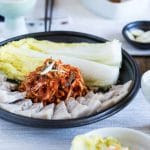


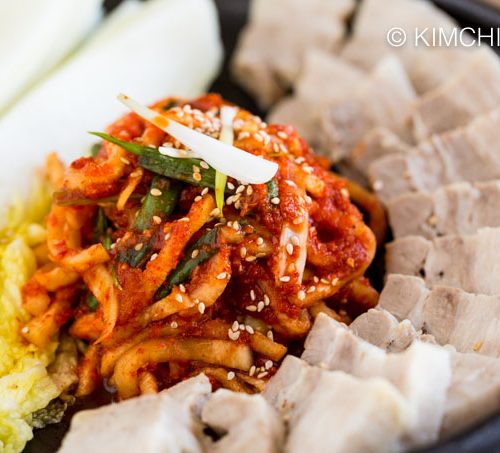
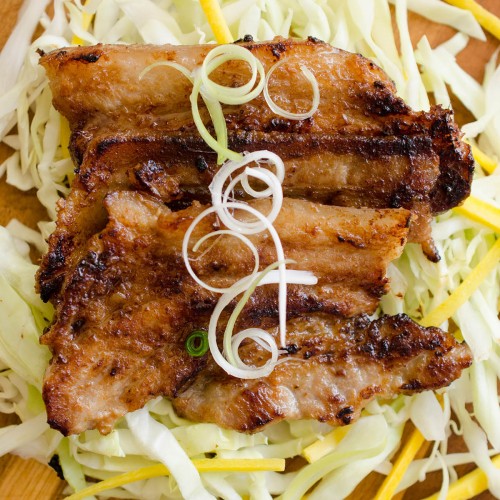
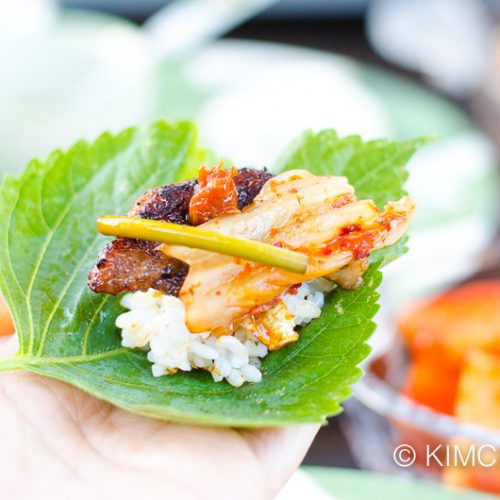

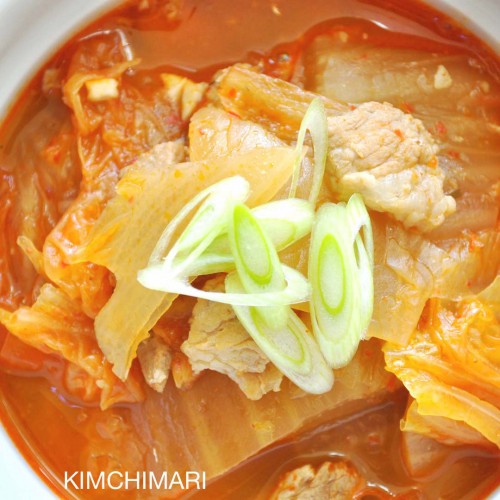
















Hello! Thank you for amazing recipe and pictures. I saw in the pork part, there is coffee beans listed but I don’t see the use of it in the instructions. Did I miss it somewhere along the post? Please help. Thanks again.
Oh no I must have missed it. Yes just add the coffee beans with the ginger when you start cooking the pork. Thank you so much for checking with me. Will correct it asap!
I love everything about this post, from photos to recipe, it’s all just amazing! Thanks for sharing!
Thank you so much Sean!! So happy and grateful to hear that. Cheers!
Testing comment
Healthy cabbage wraps, pork belly popular around the world, kimchi everyone is trying similarly . . . .what a great, fun, different recipe not hard for foodies in other countries to copy . . . thanks !
You are so right – it would be something that people around the world would enjoy. Thank you so much for leaving me a comment.
Great recipe! Love the details.
Thank you!